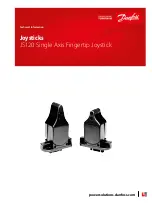
Calibration Procedures
2/03
10260A Series Actuators – Installation, Operations, and Maintenance
33
4.5 Setting Auxiliary Switches (actuators mfd. after 1/1/03)
WARNING
While the unit is powered, a potentially lethal shock hazard exists inside the case.
ATTENTION
The first two cams (starting from the back) are for the 0 % and 100 % end of travel limit switches and should
not need any adjustments as they are factory set to stop the actuator at 0 % and 100%. See Section 4.3 for
setting end of travel limit switches (Switches #1 and #2).
If optional auxiliary switches were ordered, these switches are not set by the factory. Switch settings should
be set so that switch #3 operates in synchronism with switch #1 (i.e., both activating when the actuator is
going in the same direction) and switch #4 to operates in synchronism with switch #2, etc.
To adjust the next auxiliary switch cams (see Figure 4-3):
1. Remove the terminal cover (Figure 1-1).
2. Using a slotted screwdriver on the slots at the edge of the cams, or your finger, rotate the cams until the
switches are set (see Figure 4-1).
3. The auxiliary switches should be set so switches #3 and #5 operate in synchronism with switch #1 (i.e.,
both activating when the drive is going in the same direction) and set switches #4 and #6 to operate in
synchronism with switch #2.
For Switches #3 and #5:
4. Rotate the actuator shaft, using the manual handwheel or the auto/manual switch, to the desired low
scale position.
5. Rotate the #3 switch operating cam to activate at this position. The switch roller arm should go from
being in an up, not depressed state, to a depressed state as the cam is rotated in the direction of the
shaft rotation going toward the limit position. This will cause the switch to go from NC to NO when
the switch activates. Switch activation may be detected by the clicking sound or with a continuity
tester connected to the terminals. Both the NC and NO contact states are available to the customer at
the terminals (see Figure 3-11).
For Switches #4 and #6:
6. Rotate the actuator shaft, using the manual handwheel or the auto/manual switch, to the desired up
scale position.
7. Rotate the #4 switch operating cam to activate at this position. The switch roller arm should go from
being in an up, not depressed state, to a depressed state as the cam is rotated in the direction of the
shaft rotation going toward the limit position. This will cause the switch to go from NC to NO when
the switch activates. Both the NC and NO contact states are available to the customer at the terminals
8. No additional adjustments are required.
9. Double check limit switch actuation by first manually driving the actuator to each end of travel and
hearing the switch click or by detecting it with a continuity tester. Secondly, drive the actuator to both
ends of travel (using the auto/manual switch or by providing minimum and full input signal) and make
sure the switches activate.
Clockwise and counterclockwise rotation is the direction of the output shaft when facing the end of the
shaft. As shown, clockwise rotation of the output shaft activates Switch 3 and Switch 5 similar to Limit
Switch 1. Counterclockwise rotation of the output shaft activates Switch 4 and Switch 6 similar to Limit
Switch 2.
Terminal numbers are next to circles (see Figure 3-11).
Содержание HercuLine 10260A
Страница 10: ...x 10260A Series Actuators Installation Operations and Maintenance 2 03 ...
Страница 36: ......
















































